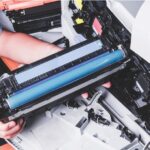What Are the Benefits of Collating when Printing Multiple Pages
When printing multiple pages, it’s important to consider the advantages of collating. Collating is a process of putting document pages in a sequential order, which ensures that printed documents are easy to read and understand.
By collating when printing, it is possible to save time and effort, as the pages are automatically organized in a logical order. Additionally, it eliminates the hassle of having to manually organize multiple pages. This is especially useful for large documents and presentations that can contain hundreds of pages. It enables efficient and accurate printing, reducing the chances of errors due to incorrect page order. In this blog post you’ll learn about what is collating and it benefits of collating when printing multiple pages.
What Is Collating?
Collating is a process of gathering and arranging multiple copies of documents, such as copies of page 1, page 2, page 3, in a specific sequence or order. It is a term used in printing services, and it is one of the most common printing options.

When you find the “collate” option in printer’s print settings or print preview, it means to collect or arrange multiple sheets of paper within a press. Collation is required when printing multiple copies of a document, such as a brochure, flyer, booklet, perfect bound book, or handout.
The term “collate” was initially used to describe the manual sorting of pages into the correct order. However, with the advent of modern technology, it is now possible to collate pages automatically, without the need for extra work.
Benefits of Collating When Printing
Collating is the process of gathering and arranging multiple sheets of paper within a printing job in a specific order. It is one of the most common terms used in the printing process. Collate printing refers to the process of printing multiple copies of a document in a specific sequence. It is an option to collate pages within a multi-page print job.
Collating brings tremendous advantages such as time, cost and resource efficiency. This is because it eliminates the need to manually collate pages in the correct order. The need to stack printed documents in a specific sequence becomes unnecessary as it can be done in a single pass.
Time Savings
The time savings that come from utilizing the collate option are undeniable. For example, if you want your pages to print in a book-like fashion, it would take much longer to manually arrange and stack the printed pages in the correct order.
With the collate option, you can submit one print job and it will produce sets of documents, all collated for you. It can take a matter of seconds, while manually collating a 20-page document could take minutes, if not longer.
All hard disk space and resources are also more efficiently used with the collate option, as it prints only what is necessary. The time saved when using the collate option can vary depending on the types of documents being printed and the quantity required, but one thing is certain:
Cost Savings
Collating has many practical benefits. One of these is cost savings. As a printer technician, I’m always happy to explain how collation can save clients money.
For book printing, uncollated documents would require multiple print jobs and would result in many separate sets of the same pages. That means that if a client was printing a 20-page booklet, they would need to submit 20 separate print jobs, resulting in 20 copies of page 1, 20 copies of page 2, and so on. This would require a lot of extra work and resources, and would cost much more than submitting one print job with the collate option enabled.
Examples of collated documents that you’ve probably seen include perfect bound books, brochures, flyers, and handouts.
Resource Efficiency
When it comes to resource efficiency, collating plays an important role. Taking the term “collate” to mean gathering and arranging documents, it provides a means to collect multiple pages into one packet. This eliminates the extra work of manually gathering and arranging multiple copies of a document, saving time and energy which can be better used elsewhere. This also ensures that the printed documents will be in the correct order, meaning one does not have to manually collate the pages afterwards.
With the collate option enabled, the printer will automatically print the pages in the correct logical sequence. This means that if one is printing a 20-page booklet, the printer will produce sets of documents that are already collated.
Increased Productivity
Collating is an essential part of printing multiple copies of a document. It involves the gathering and arranging of printed pages in a specific order. Collating can help save time and increase productivity, as it eliminates the need to manually assemble multiple copies of a document.
Without the collate option, you would have to manually collate each copy, which can be time consuming and tedious. With the collate option, the printer does all the work for you, producing sets of documents in the correct order.
Improved Organization
In addition to increased productivity, one of the most important aspects of collating is improved organization. Collating means to collect, gather, and arrange multiple copies of documents, such as printed pages, in a specific sequence or order.
Different Types of Collating
Collating is an important part of the printing process, and comes in many forms. You’ve probably seen the term ‘collate’ when submitting a print job, so what does it mean? Collating is the process of gathering and arranging printed sheets of paper into a predetermined order.

Manual collating is the process of hand arranging printed sheets of paper into the desired order. Automated collating is the process of using machines to speed up the process. Numerical collating is the process of sorting printed documents in numerical order, allowing them to be produced in sets.
Manual Collating
Whether you’re a printer technician or just a regular user, you’ve probably seen the term “collate” before. To collate simply means to gather and arrange documents or sheets of paper in a predetermined order.
Manual collating is one of the most common means to collect printed documents in a specific sequence. This is usually done by gathering multiple copies of a document and arranging them in the correct order, page by page.
Automated Collating
Automated collating is a much faster and more efficient process than manual collating, and is the most common type of collating. This type of collating requires no extra work on behalf of the printer technician.
By using a computer and a printer with a collating option, the printer technician can easily and quickly produce sets of documents in numerical order. Automated collating also allows for more precise collation, allowing for a complete set of documents in the correct sequence.
Numerical Collating
Numerical collating is probably the most common of all. Numerical collating is the process of gathering and arranging printed documents in a specific numerical order. This process produces sets of documents that are printed in the correct order.
Often times when a printer technician is asked to collate a print job, they are referring to numerical collating. This type of collating is found in a variety of print settings or print preview options, and can be enabled or disabled as needed. For example, when printing a document with multiple pages, you can choose to print collated or uncollated.
How to Collate Properly
Knowing how to collate properly can save a lot of time and hassle when it comes to printing. Collating simply means gathering and arranging printed documents in a specific order. It is something you have probably seen in print settings or print preview when printing a document. To collate properly, you will need to select the right equipment and set up the job correctly.
Selecting the Right Equipment
Selecting the right equipment can mean the difference between a successful collation job and a headache. When selecting the equipment, it is important to consider the type of job being done. A digital printer may be sufficient for a small job but a large-scale print job may require a specialized printing press. Additionally, the printer should be equipped with the right settings that will enable the job to be done correctly.
Setting up the Job
Now that you understand what collation means, it’s time to find out how to do it properly! Setting up the job correctly is key to achieving the desired printing outcome. First, you need to select the right equipment and make sure you have the right settings configured. You’ll also need to make sure the paper stock is suitable for collation, as some media won’t handle it properly.
Once all that’s done, the collation process can begin. You’ll need to arrange the pages in the correct order and make sure they are all printed in the desired sequence. If you’re printing a multi-page document, then you may need to submit several print jobs in order to gather all the pages in the right order.
Troubleshooting Common Issues
When it comes to troubleshooting common issues with collating, printer technicians have probably seen it all. In order to collate a document properly, the right equipment must be selected and the job must be set up correctly. The term collate refers to the gathering and arranging of pages in order to create a complete set in a logical sequence.
Conclusion
Collating is one of the most useful features of a printer, and can make a big difference when printing multiple pages. It ensures that the pages are printed in the correct order, eliminating the need to manually sort through them. Not only does this save time, but it also avoids any confusion and ensures that the complete set of printed documents is in the right order.
For those who need to print larger numbers of documents, automated collating can make the task even easier. It can produce sets of documents in a logical sequence and in the correct order quickly and easily. This is an invaluable feature for those who need to submit sets of pages in a predetermined order. With the right settings, collating can offer significant benefits when printing multiple pages.
You can contact us by phone, email, or by visiting our offices:
- Phone: (386) 261-8323
- Email: contact@smarttechfl.com
- Address: 771 Fentress Blvd. #10, Daytona Beach, FL 32114











